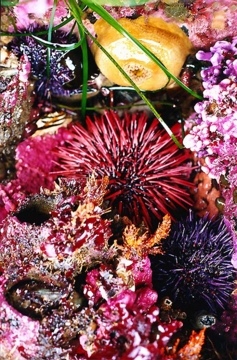| OBJECTIVES: After doing this project, you will be able to: a) Outline what is meant by the structure and Function of an Ecosystem using as an example an ecosystem near where you are living.
b) Analyze how the effects of vertical stratification in your ecosystem produce a number of different micro-habitats, and predict the effect of this on organisms. c) Describe the causes of horizontal distribution in several examples from the Race Rocks Ecosystems and then show similar examples in your own ecosystem d) Document the kind of abiotic factors which are important in the Race Rocks Ecosystems and then describe those which determine your own ecosystem. e) Model the process of Energy flow in an ecosystem. f) Model how Biogeochemical cycles operate in ecosystems. g) Add the coastal classification designation to the level of the biotope to your observations . h) Determine how the presence of rare species may be determined by environmental factors. |
| PROCEDURE: Introduction: 1. Table 1 below shows one outline of the way that we can look at any ecosystem. You can see that there are a number of completely different components, which alone do not mean much. When taken together however, they help us to understand how the ecosystem is really working. In fact they help us to create a better “Model” of how the ecosystem works. Since many of our environmental concerns today are related to how we are damaging, interfering with, modifying or restoring ecosystems, it is useful to know how these whole systems work.. Take a full page and make an outline in a notebook with spaces similar to those shown in Table 1. Use this outline to help guide you through the different parts of Structure and Function. Make notations in the boxes to help you remember important points about how you will look at your own ecosystem. |
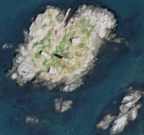 2. One of the advantages of using Race Rocks as a model to study ecosystems is that many parts of these components can be studied remotely on the internet. Go to this file to see how you might use the robotic cameras to study the horizontal distribution of the ecosystem. It also provides several examples of how you can determine horizontal distribution of organisms. 2. One of the advantages of using Race Rocks as a model to study ecosystems is that many parts of these components can be studied remotely on the internet. Go to this file to see how you might use the robotic cameras to study the horizontal distribution of the ecosystem. It also provides several examples of how you can determine horizontal distribution of organisms. |
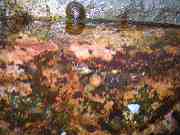 3 . Since Race Rocks is rather devoid of trees, the vertical distribution of the ecosystem is not so obvious. It is however an important factor on a different scale, in the intertidal zone, in the tidepools, on the thinly vegetated rock surface and even below the ground. See this file on vertical distribution on the Race Rocks website which documents some of these variations. Then design your own protocol for analyzing the effect that vertical stratification has on the abiotic factors affecting the species of an ecosystem. |
| 4. Biotic components comes next in our attempt to model the structure of the Ecosystem. All ecosystems have a set of organisms which are specific to that ecosystem. In some cases, the set of organisms indeed is the defining character of the ecosystem. We speak of “index species” or “the biotope” to help us define and characterize the ecosystem. On racerocks.com, we are continually updating the list of organisms which occur in the many definable micro-ecosystems of Race Rocks.
The students of the Biology and Environmental Systems classes of Lester Pearson College have helped in the production of the Race Rocks Taxonomy. If you go to that link, shown below, you can work through the hierarchy of a system of classification which allows you to pull up photographs, videos and descriptions of the species we have identified. Also a set of directions which can help you to set up your own taxonomy of an ecosystem near you can be found in the Adopt an Ecosystem assignment.In order to be sure that you understand how our Taxonomy works, we will go through the process of looking for information on the Elephant seal. a) From the racerocks.ca home page click on the Ecosystem icon. b) Select the image of The Race Rocks Taxonomy.
|
5. Rare and Endangered Species: In some areas you will have rare, or endangered species. The abiotic factors 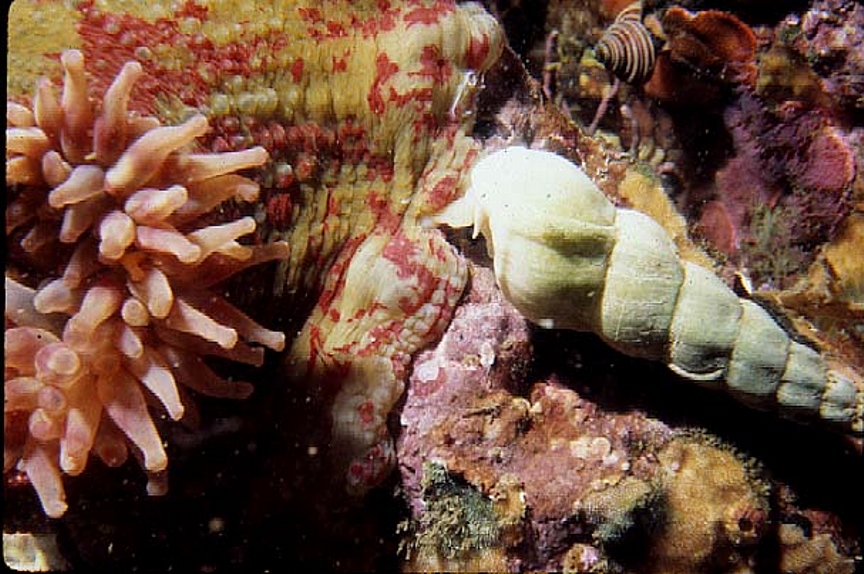 may be so specific that only few organisms have adapted to survive in that ecological niche. Choose one of the species shown here that have been sighted only occasionally at Race Rocks, and propose an hypothesis about how environmental factors may determine the distribution of the rare species. It is anticipated that changing climatic conditions as the result of anthropogenic impact might lead to a change in the species that can tolerate the environmental conditions of the future. may be so specific that only few organisms have adapted to survive in that ecological niche. Choose one of the species shown here that have been sighted only occasionally at Race Rocks, and propose an hypothesis about how environmental factors may determine the distribution of the rare species. It is anticipated that changing climatic conditions as the result of anthropogenic impact might lead to a change in the species that can tolerate the environmental conditions of the future. |
| 6. We will now look at a new concept which involves classification of Coastal Ecosystems in terms of the “Biotope” The Biotope represents the quantum unit of the habitat combining both the abiotic habitat and its fixed biotic components. |
7. Many of the abiotic components of the Structure of an Ecosystem are monitored at Race Rocks, and are indexed here in the  Index of Race Rocks Environmental Data Index. . Index of Race Rocks Environmental Data Index. .
Review this index, noting in particular that there are three sections devoted to : |
8. In the ECOSYSTEM FUNCTION section, Energy flow is modelled by a diagram showing the flows of a part of the food web for Race Rocks.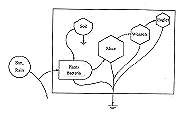
Go to this exercise to see what is involved in modelling energy flow and then draw your own energy flow models of your favorite ecosystem. |
| 9.Biogeochemical cycles represent the other part of the FUNCTION of ECOSYSTEMS. In this part of the assignment, you will be able to assemble some examples of biogeochemical cycles from images of Race Rocks, and from this get the ideas of how to model your ecosystem’s biogeochemical cycles. |
| TABLE 1. Structure and Function of Ecosystems |
|
1.0 ECOSYSTEM STRUCTURE
|
|
||||||||||||||||||||||||||||||||||||||||
|
2.0 ECOSYSTEM FUNCTION
|
|
| 10.Extension materials: Report on how a research team is studying the Structure and Function of other Ecosystems. Use one of the following external links:ARCTIC and ALPINE Ecosystem Structure and Function Research.<.http://instaar.colorado.edu/research/ecosystems.html> |

